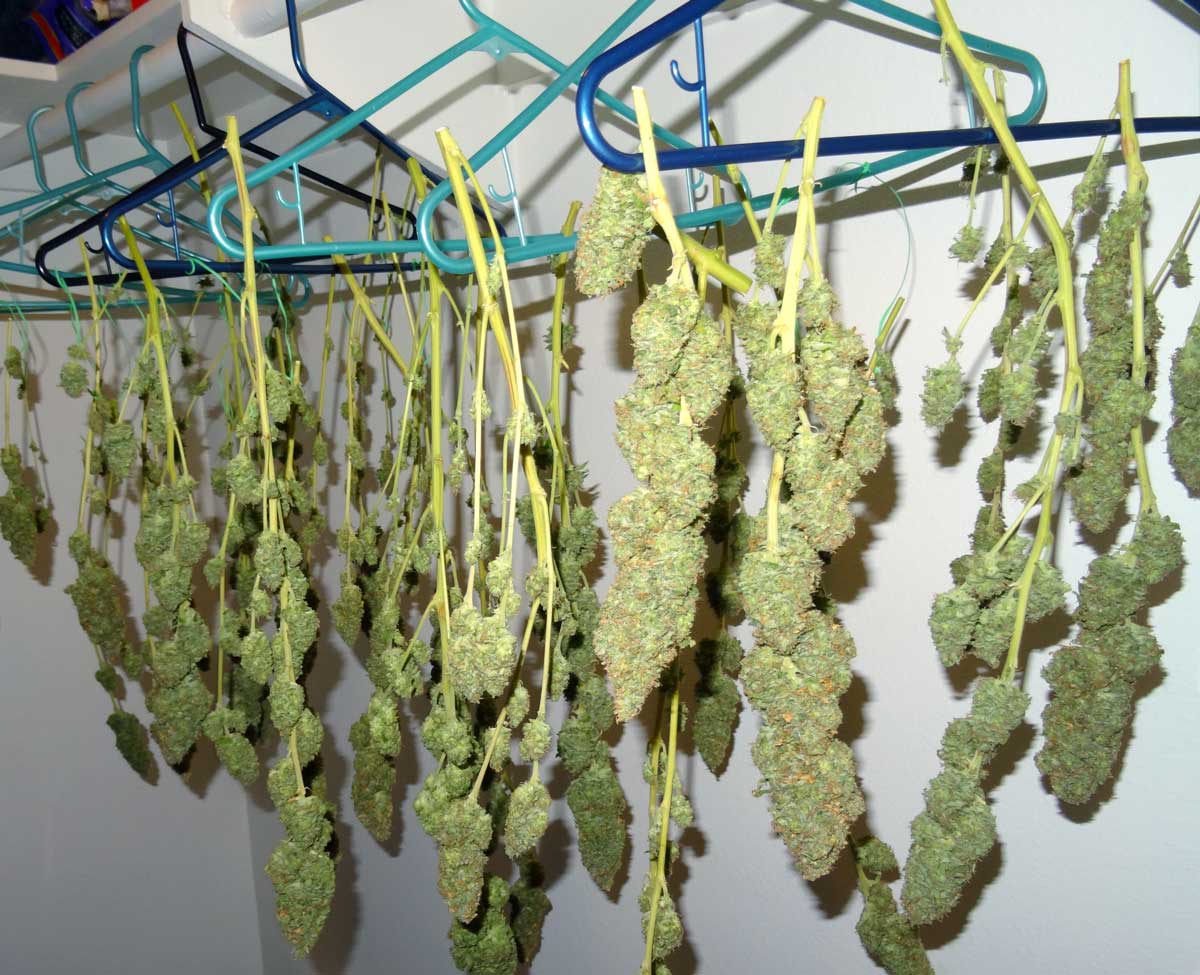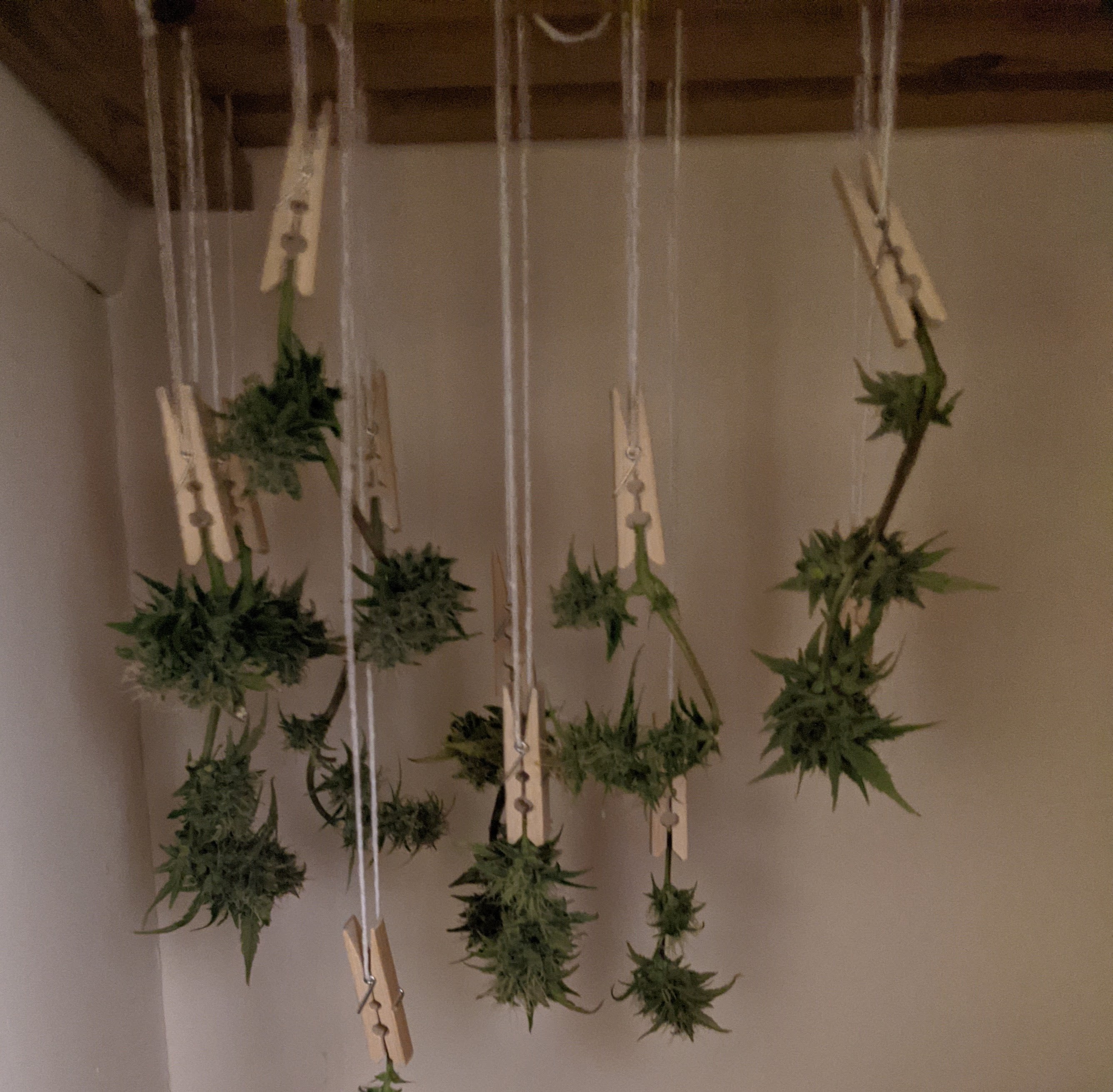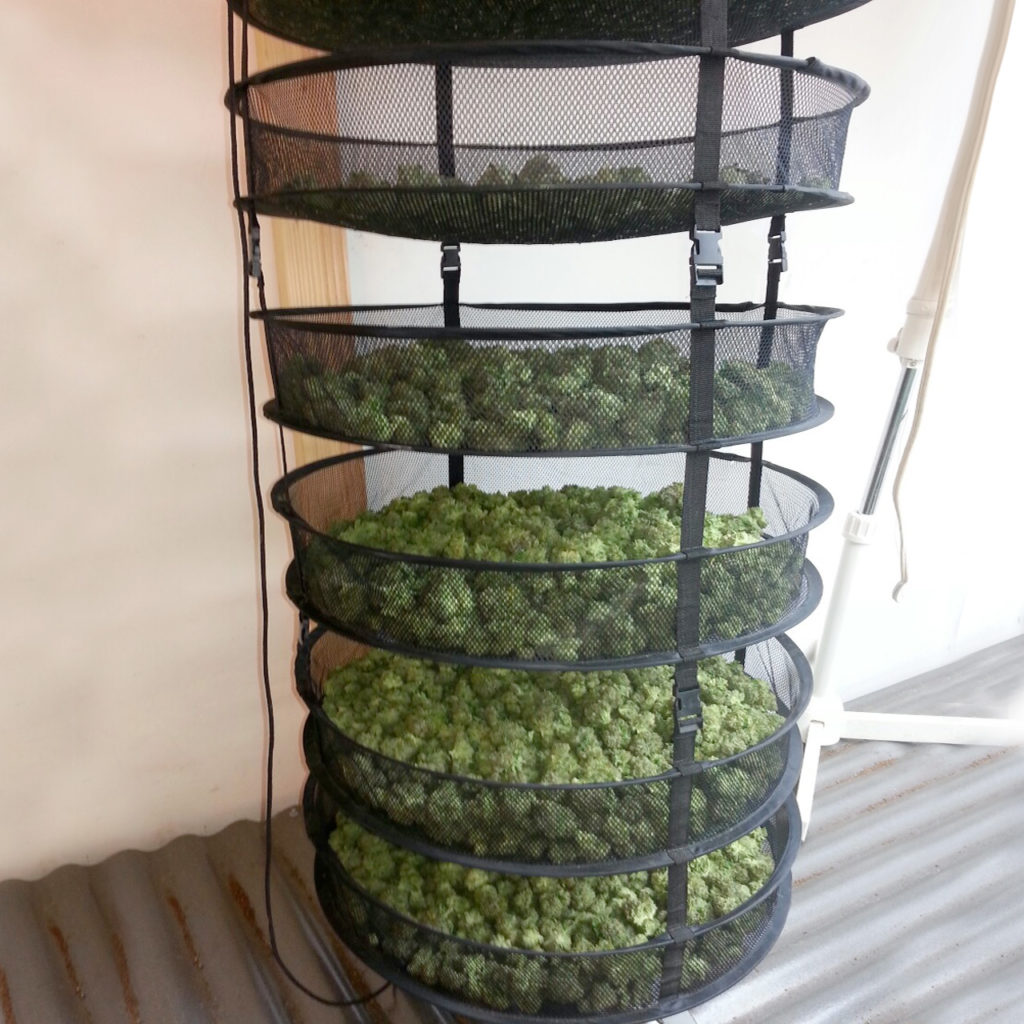Harvesting, Drying and Curing: Difference between revisions
m (fixed link) |
|||
| (One intermediate revision by the same user not shown) | |||
| Line 1: | Line 1: | ||
| − | The |
+ | The color of the plants [[Anatomy_of_Cannabis#Trichomes|trichomes]] can give a good indication of the amount of THC and CBD and thus the optimum time to harvest. It is recommended to use a jeweler's loupe or USB microscope to observe the color. Most growers harvest their cultivar when a third of the trichomes have turned amber, by this time most of the trichomes are full of THC. Trichomes turn amber when the THC has turned into CBD. There are also other indicators of maturity such as the color of the stigma, the size of the calyx, and water intake which should lower during flowering. |
== Trimming == |
== Trimming == |
||
| − | Trimming is the process of removing fan leaves and [[Anatomy_of_Cannabis#Sugar_leaves|sugar leaves]] from the buds of the plant. Trimming before drying is referred to as a wet trim and after drying is referred to as a dry trim. |
+ | Trimming is the process of removing fan leaves and [[Anatomy_of_Cannabis#Sugar_leaves|sugar leaves]] from the buds of the plant. Trimming before drying is referred to as a wet trim and after drying is referred to as a dry trim. Leaves removed from the buds during trimming can be used to make edibles. |
| − | Leaves removed from the buds during trimming can be used to make edibles. |
||
== Drying == |
== Drying == |
||
| − | Buds are generally hung to dry in a warm dry location after trimming. The [[Temperature_and_Humidity|temperature and humidity]] of the drying space will affect how long the buds take to dry. In the process of drying biological processes continue inside of the buds and complex carbohydrates and chlorophyll |
+ | Buds are generally hung to dry in a warm dry location after trimming. The [[Temperature_and_Humidity|temperature and humidity]] of the drying space will affect how long the buds take to dry. In the process of drying biological processes continue inside of the buds and complex carbohydrates and chlorophyll are converted into simple carbohydrates such as glucose. Drying slowly is preferable as it ensures the maximum breakdown of sugars and also that the inside of the bud is as dry as the outside. Buds should be left to dry until the stems bend but are somewhat firm when pressure is applied, then they should be stored in air-tight glass jars for curing. If the air humidity in the jar is over 70%, the buds are not yet dry enough to be stored for curing. Leaving the jar lid open can help lower air humidity until it is below 70% when closed. |
| − | Buds should be left to dry until the stems bend but are somewhat firm when pressure is applied, then they should be stored in air-tight glass jars for curing. If the jars humidity is over 70%, the buds are not yet dry enough to be stored for curing. |
||
Note: It is not recommended to smoke under-dried weed as it can induce a headache. |
Note: It is not recommended to smoke under-dried weed as it can induce a headache. |
||
| − | |||
| − | |||
| − | |||
=== Drying setup examples === |
=== Drying setup examples === |
||
| Line 24: | Line 19: | ||
== Curing == |
== Curing == |
||
| − | Curing is an essential part of producing marijuana that is smooth to smoke. The quality of the bud can continue to improve for |
+ | Curing is an essential part of producing marijuana that is smooth to smoke and has a strong terpene expression. The quality of the bud can continue to improve for up to 2 months '''or''' until the moisture content of the bud becomes too low. If buds are stored below ~55% RH they will very quickly lose the moisture content required for curing. In order to produce the highest quality buds the curing time should be extended for as long as possible. |
| + | |||
| − | Once buds are dried they should be stored in an air-tight container preferably glass and "burped" (left open for 15 minutes) every day for a week or two, and then burped approximately once a week. |
+ | Once buds are dried they should be stored in an air-tight container preferably glass and "burped" (left open for 15 minutes) every day for a week or two, and then burped approximately once a week. Burping the jars, or in other words, replacing the air inside is required to regulate the humidity and remove organic compounds that build up in the air. |
| + | |||
| + | The ideal humidity for curing is between 60-65% RH. |
||
| − | + | The recommended humidity for long-term storage is 62%. |
|
==References== |
==References== |
||
Latest revision as of 20:10, 2 December 2022
The color of the plants trichomes can give a good indication of the amount of THC and CBD and thus the optimum time to harvest. It is recommended to use a jeweler's loupe or USB microscope to observe the color. Most growers harvest their cultivar when a third of the trichomes have turned amber, by this time most of the trichomes are full of THC. Trichomes turn amber when the THC has turned into CBD. There are also other indicators of maturity such as the color of the stigma, the size of the calyx, and water intake which should lower during flowering.
Trimming
Trimming is the process of removing fan leaves and sugar leaves from the buds of the plant. Trimming before drying is referred to as a wet trim and after drying is referred to as a dry trim. Leaves removed from the buds during trimming can be used to make edibles.
Drying
Buds are generally hung to dry in a warm dry location after trimming. The temperature and humidity of the drying space will affect how long the buds take to dry. In the process of drying biological processes continue inside of the buds and complex carbohydrates and chlorophyll are converted into simple carbohydrates such as glucose. Drying slowly is preferable as it ensures the maximum breakdown of sugars and also that the inside of the bud is as dry as the outside. Buds should be left to dry until the stems bend but are somewhat firm when pressure is applied, then they should be stored in air-tight glass jars for curing. If the air humidity in the jar is over 70%, the buds are not yet dry enough to be stored for curing. Leaving the jar lid open can help lower air humidity until it is below 70% when closed.
Note: It is not recommended to smoke under-dried weed as it can induce a headache.
Drying setup examples
Curing
Curing is an essential part of producing marijuana that is smooth to smoke and has a strong terpene expression. The quality of the bud can continue to improve for up to 2 months or until the moisture content of the bud becomes too low. If buds are stored below ~55% RH they will very quickly lose the moisture content required for curing. In order to produce the highest quality buds the curing time should be extended for as long as possible.
Once buds are dried they should be stored in an air-tight container preferably glass and "burped" (left open for 15 minutes) every day for a week or two, and then burped approximately once a week. Burping the jars, or in other words, replacing the air inside is required to regulate the humidity and remove organic compounds that build up in the air.
The ideal humidity for curing is between 60-65% RH.
The recommended humidity for long-term storage is 62%.


